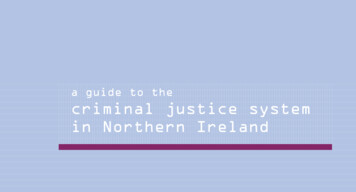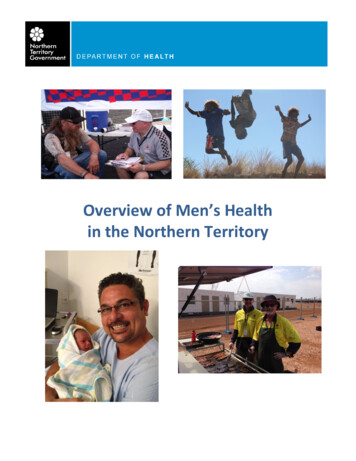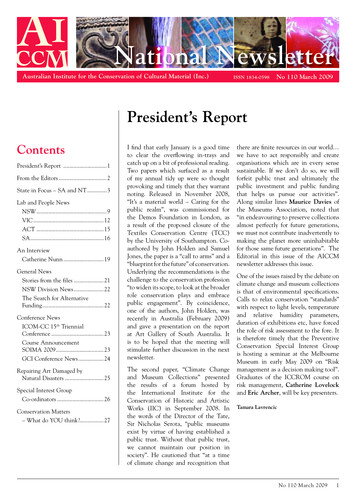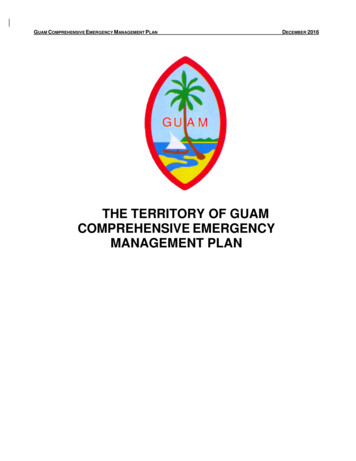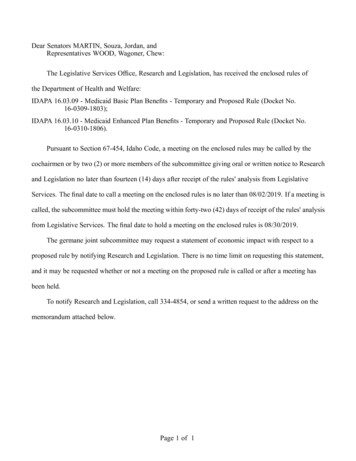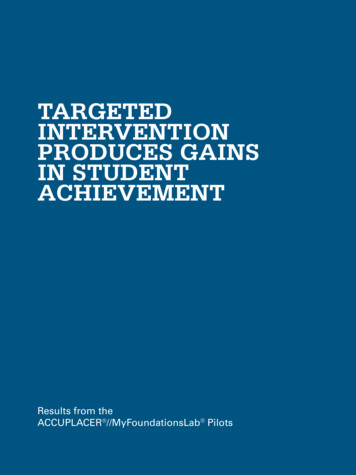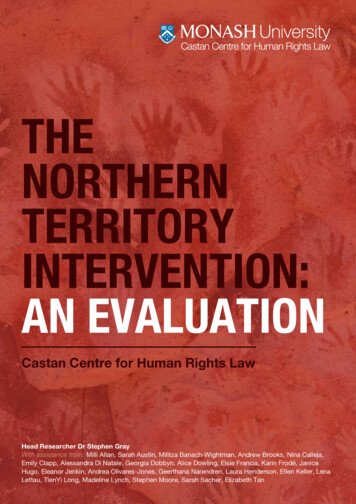
Transcription
THENORTHERNTERRITORYINTERVENTION:AN EVALUATIONCastan Centre for Human Rights LawHead Researcher Dr Stephen GrayWith assistance from: Milli Allan, Sarah Austin, Militza Banach-Wightman, Andrew Brooks, Nina Calleja,Emily Clapp, Alessandra Di Natale, Georgia Dobbyn, Alice Dowling, Elsie Francis, Karin Frodé, JaniceHugo, Eleanor Jenkin, Andrea Olivares-Jones, Geerthana Narendren, Laura Henderson, Ellen Keller, LenaLettau, TienYi Long, Madeline Lynch, Stephen Moore, Sarah Sacher, Elizabeth Tan
The Northern Territory Intervention: An EvaluationCONTENTS1. WHAT IS THE NORTHERN TERRITORY INTERVENTION?.72. THE NORTHERN TERRITORY INTERVENTION MEASURES.92.1 THE INTERVENTION IN 2007.92.2 CHANGES UNDER SUCCESSIVE GOVERNMENTS.102.3 THE INTERVENTION AND CLOSING THE GAP CAMPAIGN.122.4 EVALUATING THE INTERVENTION.143. THE INTERVENTION AND CLOSING THE GAP CAMPAIGNS:HAVE THEY BEEN ACHIEVED?.173.1 EMPLOYMENT AND ECONOMIC PARTICIPATION (2/10) .173.2 EDUCATION (6/10) .203.3 HEALTH AND LIFE EXPECTANCY (4/10) .233.4 SAFER COMMUNITIES (4/10) .263.5 LOWERED INCARCERATION RATES (0/10).31Northern Territory Intervention: An EvaluationFebruary 2020The Castan Centre for Human Rights LawThe Castan Centre, based in the Law Faculty at MonashUniversity, is a world-renowned academic centre using itshuman rights expertise to create a more just world wherehuman rights are respected and protected, allowing peopleto pursue their lives in freedom and with dignity. The Centre’sinnovative approach to public engagement and passion forhuman rights are redefining how an academic institution cancreate important and lasting change.24. THE INTERVENTION AND HUMAN RIGHTS.354.1 GENERAL COMPLIANCE (4/10) .354.2 SPECIAL MEASURES (3/10).374.3 RACIAL DISCRIMINATION (2/10).384.4. RIGHT TO SELF-DETERMINATION (1/10).404.5 SOCIAL AND CULTURAL RIGHTS (3/10).424.6 RIGHT TO BE CONSULTED (2/10).444.6 RIGHT TO SOCIAL SECURITY (1/10) .464.6 RIGHTS OF CHILDREN (1/10) .494.7 GENOCIDE (0/10).533
The Northern Territory Intervention: An EvaluationOVERVIEWWAS4/10NOW4/10The Intervention and Closing the mployment and Economic ParticipationEvaluation: Indigenous employment in the Northern Territory has fallen significantly since2010, due in large part to the discontinuation of the Community Development EmploymentProjects (CDEP), the lack of work opportunities following the end of the mining boom, thelack of transport infrastructure, low education levels and investment uncertainty due to landtenure changes. To learn more, see pages 17-19.NORATINGEducationEvaluation: Improvements include the introduction of holistic programs to encourage earlychildhood enrolment, improved reading, writing and numeracy outcomes for Indigenousstudents and record year 12 completion rates. The Northern Territory still however lagssignificantly in Indigenous attendance levels, ability to meet national minimum educationstandards, completion of year 12 and year 12 results. Further, Indigenous students in remoteareas continue to face serious barriers to education. To learn more, see pages 20-22.NORATINGNORATINGSafer CommunitiesNORATINGEvaluation: Indigenous women still face the highest rates of domestic violence. Further,Indigenous children are still 8 times more likely than their non-Indigenous counterparts toreceive child protection services, and 11 times more likely to be in out-of-home care inthe NT. However, there are some signs of positive change, including a recent reduction inassaults and some violent crimes. This is likely to be contributed to by alcohol reductionprograms, including floor prices for alcohol and a banned drinkers’ register. To learn more,see pages 26-30.NORATING3/102/100/10Evaluation: Indigenous imprisonment rates continue to increase in the NT, with ATSIpeoples accounting for over 80% of the prison population. Indigenous youth are alsodisproportionately represented in juvenile justice centres, and subject to appalling andinhumane conditions. Governments have still not committed to a clear target to reduceincarceration rates. To learn more, see pages 31-33.NORATINGNORATING4Evaluation: Measures in the Northern Territory have been highly criticised for their impacton human rights including the right to freedom from racial discimination, the right to selfdetermination, the right to be consulted, the right to social security, the rights of children,and freedom from Genocide. To learn more, see pages 34-36.Evaluation: Measures in the Northern Territory continue to wrongfully allow racialdiscrimination against Indigenous peoples under the guise of advancing other humanrights. In part this is because these measures were implemented without consultation andconsent from Indigenous groups affected. To learn more, see pages 37-38.Racial DiscriminationEvaluation: Increasingly discriminatory employment measures are being exacted againstIndigenous communities in the NT. The proposed introduction of a cashless debit card islikely to exacerbate this issue. Overall, there is substantial evidence to suggest that racialdiscrimination against Indigenous peoples remains prevalent. To learn more, seepages 38-39.Right to Self determination1/103/102/101/10Incarceration rates0/10Overall ComplianceSpecial MeasuresHealth and Life ExpectancyEvaluation: Improvements include a decrease in child mortality and a decreased lifeexpectancy gap since the last evaluation. Nevertheless, the Northern Territory still has thehighest rates of child mortality and the widest life expectancy gap in Australia. Further,Indigenous Australians continue to experience disproportionately high rates of chronicdisease and mental illness. To learn more, see pages 23-25.Human rights and the InterventionEvaluation: Self-determination has been restricted through the continued disempowermentof Indigenous groups resulting from low voting participation, removal of financial autonomy,and removal of consideration of customary law in bail and sentencing decisions. To learnmore, see pages 40-42.Social and Cultural RightsEvaluation: Indigenous Australians continue to face barriers to property rights and controlof Indigenous territories, and are disproportionately subject to interference with the rightsto family and private life. To learn more, see pages 42-43.Right to be ConsultedEvaluation: There is continued resistance to consultation with Indigenous groups. Mostnotably, the Uluru Statement, calling for an Indigenous voice to Parliament has failed togarner bipartisan support. To learn more, see pages 44-45.Right to Social SecurityEvaluation: The enjoyment of social security has come under serious threat due tothe introduction of Income Management Schemes for prescribed communities suchas the Cashless Debit Card. Such interventionist schemes disproportionately impactupon Indigenous communities, and deny them autonomy, dignity and the right to equalenjoyment of social security. To learn more, see pages 46-48.Rights of Children1/100/10Evaluation: The rights of children continue to be undermined in the NT. In particular, theNorthern Territory Royal Commission into the Detention and Protection of Children in 2017found that the treatment of children in juvenile justice centres was in breach of Australia’sobligations under the CRC. Further, the age of criminal responsibility remains low in theNT. To learn more, see pages 50-52.GenocideEvaluation: The failure to develop adequate mechanism for reparations for for policiesthat have deliberately inflicted conditions of life calculated to bring about a Indigenouscommunities’ physical destruction - such as the forcible removal of children - remainsa critical human rights concern. Further the lack of support for intergenerational traumaexacerbates this issue. To learn more, see pages 53.5
1The Northern Territory Intervention: An Evaluation1. WHAT IS THE NORTHERNTERRITORY INTERVENTION?The Northern Territory Intervention is the colloquial name forthe Northern Territory Emergency Response (NTER) whichwas introduced by the Howard government in August 2007.The catalyst for this suite of measures was the release of the‘Ampe Akelyernemane Meke Mekarle Report’ (‘Little Childrenare Sacred Report’) which outlined then current allegationsof widespread child abuse and family violence in Aboriginalcommunities, and recommended that ‘child abuse bedesignated as an issue of urgent national significance’. It is awide range of complex and controversial measures enactedthrough the Northern Territory National Emergency ResponseAct (NTNERA) with bipartisan support.The Intervention was directed at addressing thedisproportionate levels of violence in Indigenouscommunities in the Northern Territory, as well asthe systemic disadvantage of Indigenous people,characterised by economic deprivation, unemployment,social marginalisation, inadequate housing and poorhealth and justice outcomes. It was also a directresponse to the Ampe Akelyernemane Meke MekarleReport (‘Little Children are Sacred Report’) intosexual abuse of Indigenous children. This report wascommissioned by the then Northern Territory ChiefMinister, Clare Martin, following an interview on theABC’s Lateline program, in which Alice Springs SeniorCrown Prosecutor, Dr Nanette Rogers SC, commentedthat the violence and sexual abuse of children that wasentrenched in Indigenous communities was “beyondmost people’s comprehension and range of humanexperience”. The then Commonwealth Minister forFamilies, Community Services and Indigenous Affairs,Mal Brough, indicated in his second reading speech that“[the NTNERA] and the other bills introduced in thesame package are all about the safety and wellbeing ofchildren and are designed to ensure the protection ofAboriginal children from harm”.6The Little Children are Sacred Report was the resultof in-depth research, investigation and communityconsultation over a period of over eight months bymembers of the Northern Territory Board of Inquiry.The focus of their inquiry was instances of sexual abuse,especially of children, in Northern Territory Indigenouscommunities. The findings were presented to then ChiefMinister Clare Martin in April 2007 and released to thepublic in June. The striking facts, graphic imagery andardent plea for action contained in this report saw thisissue gain widespread attention both in the mediaand in the political agenda, inciting divisive debateand discussion.The NTNERA was enacted by the Howard Governmentjust two months after the report was released tothe public, allowing little time for consultation withIndigenous communities. It was framed as a ‘nationalemergency’ with army troops being deployed toIndigenous communities in the Northern Territory. Thistook place in the lead up to the 2007 Federal Election,in which the Labor Party, under Kevin Rudd, defeatedthe Howard Government after four successive terms ofLiberal government.7
2The Northern Territory Intervention: An Evaluation82. THE NORTHERN TERRITORYINTERVENTION MEASURES2.1 THE INTERVENTION IN 2007The Intervention was a 587 million package oflegislation that made a number of changes affectingspecified Indigenous communities in the NorthernTerritory. It included restrictions on alcohol, changesto welfare payments, acquisition of parcels of land,education, employment and health initiatives, restrictionson pornography and other measures.The package of legislation introduced included: Northern Territory National Emergency ResponseAct 2007 Social Security and Other Legislation Amendment(Welfare Payment Reform) Bill 2007 Families, Community Services and Indigenous Affairsand Other Legislation Amendment. (Northern TerritoryNational Emergency Response and Other Measures)Act 2007 Appropriation (Northern Territory National EmergencyResponse) Bill (No. 1) 2007-2008 Appropriation (Northern Territory National EmergencyResponse) Bill (No. 2) 2007-2008In order to enact this package of legislation, severalexisting laws were affected or partially suspended,including the: Racial Discrimination Act 1975.Aboriginal Land Rights (Northern Territory) Act 1976.Native Title Act 1993 (Cth).Northern Territory Self-Government Act andrelated legislation. Social Security Act 1991. Income Tax Assessment Act 1993.A raft of reforms and regulations were introduced by thispackage of legislation, including: Restricting the sale, consumption and purchase ofalcohol in prescribed areas. This included theprohibition of alcohol in certain areas prescribedby the legislation, making collection of informationcompulsory for purchases over a certain amount andthe introduction of new penalty provisions. ‘Quarantining’ 50% of welfare payments fromindividuals living in designated communities and frombeneficiaries who were judged to have neglectedtheir children8 Compulsorily acquiring townships held undertitle provisions of the Native Title Act 1993 with theintroduction of five year leases in order to give thegovernment unconditional access. Sixty-five Aboriginalcommunities were compulsorily acquired. Linking income support payments to schoolattendance for all people living on Aboriginal land,and providing mandatory meals for children at schoolat parents’ cost. Introducing compulsory health checks for allAboriginal children. Introducing pornography filters on publicly fundedcomputers, and bans on pornography indesignated areas. Abolishing the permit system under the AboriginalLand Rights Act 1976 for common areas, roadcorridors and airstrips for prescribed communities. Increasing policing levels in prescribed communities.Secondments were requested from other jurisdictionsto supplement Northern Territory resources. Marshalling local workforces through the work-for-thedole program to clean-up and repair communities. Reforming living arrangements in prescribedcommunities through introducing market based rentsand normal tenancy arrangements. Commonwealth funding for the provision ofcommunity services. Removing customary law and cultural practiceconsiderations from bail applications and sentencingin criminal trials. Abolishing the Community Development EmploymentProjects (CDEP).Despite the Little Children are Sacred Reportemphasising the importance of entering into genuinepartnerships with Aboriginal communities, theGovernment implemented the Intervention measureswith speed. When the Bills were referred to the SenateStanding Committees on Legal and Constitutional Affairs,almost every witness lamented the “inability of primarystakeholders to meaningfully interact with the processthat was being [established] to govern them.”9
The Northern Territory Intervention: An Evaluation2.2 CHANGES UNDER SUCCESSIVE GOVERNMENTSAfter an initial focus on preventing child sexual abuse,successive Federal Governments re-designed andre-framed the Intervention. This involved linkingthe Intervention with the broader ‘Closing the Gap’campaign, introducing new measures such as the‘BasicsCard’ and tougher penalties for the possessionof alcohol and pornography. Changes were also madeto the operation of the Racial Discrimination Act (RDA)(see section on Human Rights). The current (2019-20)package of legislation retains the support of the LiberalGovernment and is due to expire in 2022.A. 2008 ChangesThe Intervention was introduced in 2007 by the HowardGovernment, but a change of government in September2007 saw the Labor Government under Kevin Rudd gainpower. After some consultation and minor changes, theNTNERA and associated legislation was maintained.In 2008, Rudd publicly apologised to the members ofthe Stolen Generations on behalf of the nation. In 2009,Rudd also declared support for the most substantiveframework for the rights of Indigenous peoples, theUN Declaration on the Rights of Indigenous Peoples(UNDRIP). The previous Howard government had votedagainst the ratification of this treaty. Article 3 of theDeclaration states that:‘Indigenous peoples have the right of self-determination.By virtue of that right, they freely determine their politicalstatus and freely pursue their economic, social andcultural development’.The failure to recognise this right to self-determinationbecame one of the major criticisms of the Intervention.In 2009, Rudd implemented the BasicsCard. This card isstill used to manage income in prescribed areas of theNorthern Territory (although a change to a new system,the ‘Cashless Debit Card’, is expected in early 2020). Itcannot be used to purchase alcohol, tobacco, tobaccoproducts, pornography, gambling products or services,home-brew kits or home-brew concentrate.During the period between 2009 and 2010, theRudd Government committed itself to a re-designof the Intervention, with a focus on reinstating the10 The tackling alcohol abuse measure: the purposeof this measure was ‘to enable special measures tobe taken to reduce alcohol-related harm to Aboriginalpeople in the Northern Territory. The land reform measure: the land reform measureenabled the Commonwealth to amend NorthernTerritory legislation relating to community living areasand town camps to enable opportunities for privatehome ownership in town camps and more flexiblelong- term leases.term leases. The food security measure: the purpose of thismeasure was ‘to enable special measures to be takenfor the purpose of promoting food security forAboriginal communities in the Northern Territory’. Themodifications create a 10 year timeframe, whilst mostprovisions, other than the alcohol measures, arereviewed after 7 years.suspended provisions of the RDA. The Social Securityand Other Legislation Amendment (Welfare Reformand Reinstatement of Racial Discrimination Act)Act 2010 (Cth) repealed the ‘special measures’ thathad been created under the original Intervention tosuspend the operation of the RDA. However, the newlegislation continued to fall foul of the RDA becauseland acquisition and compulsory income managementmeasures overwhelmingly affected IndigenousAustralians.The focus of the Government then changed slightly,concentrating more closely on the need to ‘tackle thedestructive, intergenerational cycle of passive welfare’(see then Minister for Families, Community Servicesand Indigenous Affairs Jenny Macklin’s second readingspeech). The Rudd government explicitly linked theIntervention to the Closing the Gap targets, shifting thefocus of the Intervention from the protection of childrenfrom sexual abuse to the reform of the welfare system.The key changes imposed under the 2012 StrongerFutures legislation package consisted of:B. 2012 changesThe legislative basis for the Intervention was dueto expire in 2012. It was then incumbent upon theCommonwealth government to make decisions regardingthe Intervention’s future. Under the Gillard Government,the Stronger Futures in the Northern Territory Act 2012(Stronger Futures) replaced the NTNERA and extendedthe Intervention for a further ten years to 2022. TheStronger Futures legislation comprises three principalActs (the Stronger Futures package), plus associateddelegated legislation. The three Acts are: Stronger Futures in the Northern Territory Act 2012; Stronger Futures in the Northern Territory(Consequential and Transitional Provisions) Act 2012;and Social Security Legislation Amendment Act 2012.In 2013, the Parliamentary Joint Committee on HumanRights examined Stronger Futures and the relatedlegislation in their eleventh report. They noted thatalthough the Stronger Futures legislative packagerepealed the Northern Territory Emergency Response(‘NTER’) legislation, it retained three key policy elements:10 Expansion of income management through theBasicsCard and the increase of ‘quarantined’payments. Increased penalties related to alcohol andpornography, with as much as 6-months jail time for asingle can of beer. Expansion of policy that links school attendance withcontinued welfare payments. Introduction of licences for ‘community stores’ toensure the provisions of healthy, quality food. Commonwealth given power to make regulationsregarding the use of town camps.(Sources: SBS Factbox, Stronger Futures in the NT,Listening but not Hearing Report)Although consultation with Indigenous communities didtake place, there was much criticism of the nature ofthe consultative process and the extent to which it wasacted upon. The ‘Listening But Not Hearing Report’ bythe Jumbunna Indigenous House of Learning concludedthat “the Government’s consultation process has fallenshort of Australia’s obligation to consult with Indigenouspeoples in relation to initiatives that affect them”.The Australian Council of Human Rights Agencies hasalso stated that it was ‘invasive and limiting of individualfreedoms and human rights, and require[s] rigorousmonitoring’. Amnesty International commented thatthe new package of legislation was the same as theoriginal “Intervention, but with the pretence of being nondiscriminatory.”C. 2014 changesThe current Intervention legislation is not due to expireuntil 2022.In a speech in February of 2014, then Prime MinisterTony Abbott identified the importance of closing thegap through investment in Indigenous programs, witha specific focus on school attendance. However, hisspeech was followed by substantial budget cuts toAboriginal legal and health services, early childhoodeducation and childcare, and the consolidation of 150Indigenous programs into 5 core programs. While the2015 Budget reinstated funding to Family Violencelegal services, these ongoing cuts were expectedto detrimentally affect attempts to Close the Gap inIndigenous disadvantage.The 2015 Budget modified the Stronger Futures NPA,redirecting 988.2 million in funds to a new ‘NationalPartnership Agreement on Northern Territory RemoteAboriginal Investment’ (NPA) over eight years. The NPAprioritised schooling, community safety and employment.This funding also aimed to help the Northern TerritoryGovernment assume full responsibility for the delivery ofservices in remote Indigenous communities. Additionalfunding was made available to extend the IncomeManagement Scheme until 2017. However, the NPAhalved expenditure on health measures, minimisingthe extent to which the Commonwealth could controlCouncil of Australian Governments (COAG) targetmeasures. The reduction in monetary outlay wasparticularly incompatible with the NPA’s objective ofsupporting integrated hearing and oral health servicesdirected at children in remote communities.Government administered funding of 1.4 billion,previously available under Stronger Futures, wastransferred to the NPA, but was delivered by theDepartments of Prime Minister and Cabinet and SocialServices, outside the NPA framework.11
The Northern Territory Intervention: An Evaluation2.3 THE INTERVENTION AND CLOSING THE GAP CAMPAIGNIn 2008, following the change of government after the2007 Federal Election, the Rudd Labor Governmentre-framed the Intervention through a new nationalpolicy focus on Closing the Gap. Mr Rudd’s intentionto re-work the Intervention to focus more closely onreforming the welfare system linked closely with thealready existing targets of the Close the Gap Campaign.The aims of the campaign were set out in the 2012‘National Indigenous Reform Agreement’.The Council of Australian Governments (COAG) hadidentified six areas of Indigenous disadvantage totarget as the basis for the Closing the Gap Campaign.These were:1.2.3.4.5.6.Early childhood;Schooling;Health;Economic Participation;Safe Communities; andG overnance and Leadership (see Right to SelfDetermination below).The Closing the Gap in the Northern Territory NationalPartnership Agreement (2009) ceased on 30 June 2012.The Stronger Futures in the Northern Territory packagewhich started on 1 July 2012 continued to support theClosing the Gap reforms.The 6th Annual Progress Report on Closing the Gap wastabled in Parliament by then Prime Minister Tony Abbotton 12 February 2014. It outlined the commitments madeby the Coalition government, including: Consolidating the administration of Indigenousprograms from eight government departments into theDepartment of the Prime Minister and Cabinet. Establishing the Prime Minister’s IndigenousAdvisory Council. Increasing Indigenous school attendance throughproviding 28.4 million funding for a remote schoolattendance program. Improving Indigenous access to employment bycommissioning a review and fundingemployment initiatives.12Closing the Gap Refresh Supporting a referendum for the recognition of theFirst Australians in the Australian Constitution.However, in the 10th annual progress report of 22February 2018, then Prime Minister Malcolm Turnbullacknowledged that although there is “much tocelebrate”, “continued effort and action is required”. MrTurnbull applauded the fact that Aboriginal and TorresStrait Islander people are, on average, living longer. Healso celebrated the improvements in early childhoodeducation enrolment, and improved Year 12 Attainmentrates. However, the report concluded that only 1 out of7 targets are on track to be met at a national level, andwithin the Northern Territory only the target to halve thegap in Year 12 attainment remained on track.Thus, four of the Closing the Gap targets expired in 2018(see CTG, Prime Minister’s report, 2018, p. 12). Thesewere closing the gap in school attendance by 2018(not achieved); halve the gap in reading and numeracyby 2018 (not achieved); halving the gap in employmentby 2018 (not achieved); halving the gap in Year 12attainment by 2018 (achieved).Ten years on from the initial Framework, the Governmentrecognised a need to “recommit and renew ourcollective efforts”. In 2019, the final Closing the Gapreport stated that ‘we should not let our failure to meettargets overshadow the successful, thriving lives of manyAboriginal and Torres Strait Islander Australians and thegreat work that many in our communities have beendoing’. It notes that the targets were ‘ambitious, complexand aimed at long-term, intergenerational change,without all the levers to make it happen’ (CTG Report2019, p.12).The report claimed to mark a transition to “doingthings differently”, primarily by working in partnershipwith Aboriginal people. There is nothing new aboutgovernments claiming to be working in partnershipwith Aboriginal people; the test will be whether they areactually doing so.On the 12th of December 2018, the Council of AustralianGovernments (COAG) committed to a formal partnershipwith key Indigenous Australian organisations to providea forum for consultation with respect to the Closing theGap Refresh. COAG also released a draft frameworkwhich sets out 15 targets, accountabilities and reportingrequirements that would form the basis for the nextphase of the Closing the Gap strategy. The partnershipwas formalised and came into effect in March 2019. Theagreement establishes the Ministerial Council, knownas the Joint Council on Closing the Gap which includesrepresentatives from COAG and twelve representativesfrom Coalition of Peaks. The Government announcedthat the Joint Council will be responsible for finalising therefreshed Closing Gap framework and targets, play an“ongoing role” in the implementation and performancemonitoring of the jointly agreed framework and targets,and review the National Indigenous Reform Agreementby the end of 2019.The draft targets are as follows:Families, children and youth Increase the proportion of Aboriginal and Torres StraitIslander children assessed as developmentallyon track in all five domains of the Australian EarlyDevelopment Census to 45% by 2028. 95% of all Aboriginal and Torres Strait Islander fouryear-olds enrolled in early childhood educationby 2025. Significant and sustained progress to eliminate theover-representation of Aboriginal children in out-ofhome care. A significant and sustained reduction in violenceagainst Aboriginal and Torres Strait Islander womenand children.Health Close the gap in life expectancy between Aboriginaland Torres Strait Islander and non-IndigenousAustralians within a generation by 2031. By 2028, 90-92% of babies born to Aboriginal andTorres Strait Islander mothers have a healthybirth weight.A ‘Closing the Gap refresh’ process iscurrently underway.12Education Increase the proportion of Aboriginal and Torres StraitIslander students in the top two bands of NAPLANreading and numeracy for years 3, 5, 7 and 9 by anaverage of 6 percentage points by 2028. Decrease the proportion of Aboriginal and Torres StraitIslander students in the bottom two bands of NAPLANreading and numeracy for years 3, 5, 7 and 9 by anaverage of 6 percentage points by 2028. Halve the gap in attainment
disproportionately represented in juvenile justice centres, and subject to appalling and inhumane conditions. Governments have still not committed to a clear target to reduce incarceration rates. To learn more, see pages 31-33. Overall Compliance Evaluation: Measures in the Northern Territory have been highly criticised for their impact


